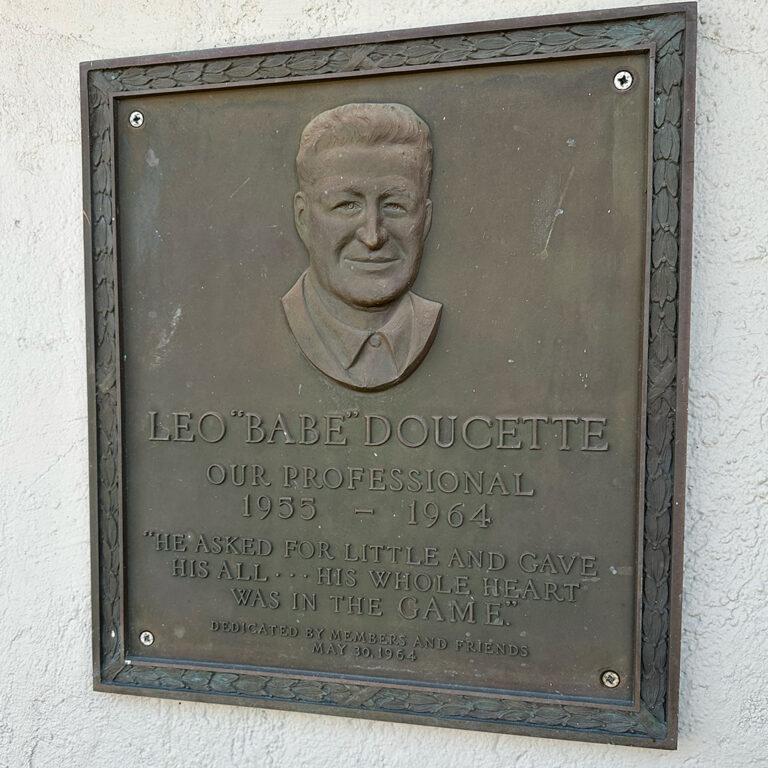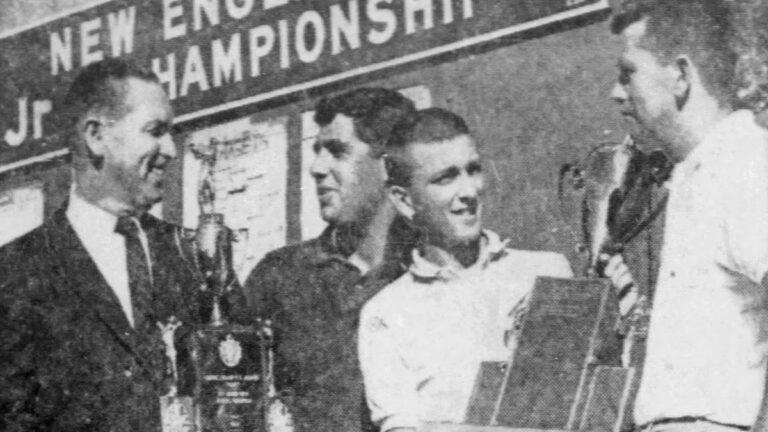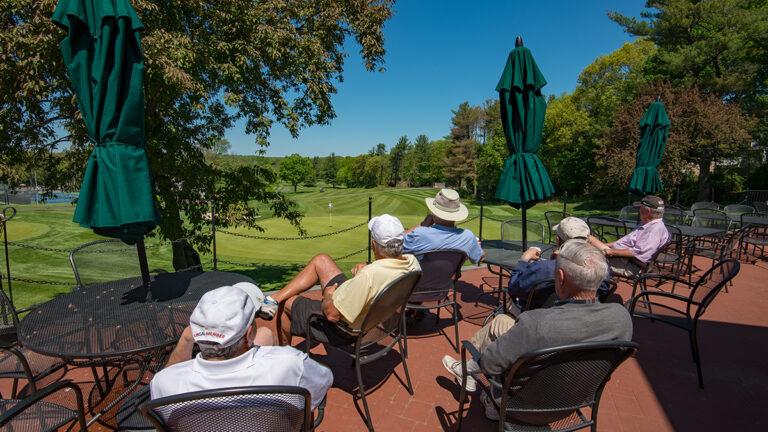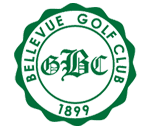BELLEVUE GOLF CLUB CELEBRATES 125 YEARS OF HISTORY
Published 3/29/2024 by Mass Golf
The year 1899 was a transformative time for the citizens of Melrose, a valley seven miles north of Boston with sweeping vistas, rich soil, and land conducive to well-kept streets and comfortable homes. Fifty years after its population broke off from the area formerly known as North Malden, Melrose citizens voted to enter the 20th century as Massachusetts' newest city.
The name Melrose came at the suggestion of William Bogle, a native Scotsman and longtime resident who lived in the area when it was North Malden, citing its resemblance to the Eildon Hills of Melrose, Scotland.
Fittingly, as Melrose was developing into a burgeoning city, the Scottish game was taking hold along its hillside pastures of the East Side. During the 1890s, members of the local tennis club called Bellevue (French for "Beautiful View") took an interest in golf. In October 1899, a group of 10 members led by George Merrill leased 30 acres of rolling hills on a former estate located on a slope referred to as Rattlesnake Hill as the location for their new neighborhood club. They laid out a 1,845-yard golf course and erected a one-story clubhouse of pasture stone and wood with broad piazzas on three sides to admire the views.
Since its founding, the club has been treasured and preserved by generations of passionate members who have guided it through promising and sluggish economic times. Bellevue's 65 acres are packed with a colorful history — filled with personalities and prestigious events — and through 125 years, it remains one of the oldest nine-hole golf clubs north of Boston.
"The legacy here is truly special," said Jeffrey Monteleone, Bellevue's PGA Director of Golf. "All the great families here, present and past, really make it feel like a great American golf club."

Bellevue's clubhouse, pro shop and first tee sits at the apex of the property. (David Colt, file)
THE COURSE
In its formative years, Bellevue was a neighborhood club with several members residing in housing surrounding or near the golf course. Upon purchasing additional land that crosses into neighboring Saugus, the original layout was quickly replaced by a 2,700-yard course. The current course routing, credited to Wayne Stiles and John Van Kleek (also credited with Thorny Lea, Marshfield, and Taconic), has largely stood the test of time. The layout is nestled within a basin with a meandering stream gushing with stormwater, deep rough, some man-made features, and swinging terrain that makes a flat lie a commodity.
Starting from the hilltop by the clubhouse, the opening stretch features four increasingly difficult par-4s, with sloped, lightning-fast greens on each one. The 437-yard par-4 is the club's signature hole and perhaps one of the best par-4s in Massachusetts. The long dogleg right features two stream crossings, with the second shot playing up to an elevated small, circular green. Tee shots that drift right off the tee will likely lead to a second shot blocked out by a tree.
In the 1920s, the state highway commission built the Lynn Fells Parkway — a main road connecting Melrose to Route 1 that runs parallel to the third and fourth holes along the club's northern boundary — through Bellevue's original layout, cutting off part of the old course.
However, the club was in good hands with then-president Clarence "Kid" Cochrane. A standout in multiple sports, Cochrane joined Bellevue in his youth and obtained a prodigious knowledge of the course and its operations. A hockey captain at MIT, he applied his architectural ingenuity by advising the remodeling of Bellevue's course, which, according to a W.A. Whitcomb column in the Boston Globe, "is conceded to be a vastly better one, for all the forced and hurried construction the changes induced." After serving another stint as Bellevue's president from 1948-50, he assumed the presidency of the Massachusetts Golf Association. During his term, he donated the Clarence G. Cochrane Trophy, now awarded to the Massachusetts Open champion.
Another significant course adaptation came on the par-3 5th, featuring a large, deep green tucked between the hillside on its left and a man-made pond on the starboard side. The hole previously featured five bunkers guarding the front with a cart path running next to the green. By introducing a pond and rerouting the path to the left hillside, the 5th is another stellar golf hole that can play between 130-180 yards.
Brian Skinner, a Melrose native who has been Bellevue's golf course superintendent since 1997, said pine tree removal around the green has significantly improved turf health. Near the beginning of his tenure as golf course superintendent, the crew added a platform tee box for the 6th (lone par-5) made of granite boulders. Playing into a valley, getting on in two is possible, but awaiting is a two-tier green that can wreak havoc depending on pin placement.
"We haven't done any major alteration since that time," said Skinner, whose experience includes a stint at TPC Sawgrass. "We've just resurfaced and refurbished some tees, so it's been consistent in that way. The course used to be cut up into different landscapes, but with the tree work we've done, you can look around and see across the landscape."

A picture from the front of the 5th green taken during the 1930s. (Contributed)

A present-day view from behind the 5th green. (David Colt, file)
After playing the final par-3 on the 8th, playing toward the pool and tennis courts, players work back to play the closer. The 355-yard 9th is an uphill dogleg right with a sneaky fairway bunker named "Big Mouth" that will swallow up low lofted or off-line drives and make the chance of closing with a par or better unlikely. Another small, circular green awaits in view of those standing atop the hill or on the top deck of the clubhouse. There used to be a separate green used for the 18th hole, but it was eventually abandoned.
"I never get bored of playing it," Skinner said of the course. "You see a different shot every time you come out here and play."
EARLY DAYS
In 1903, Bellevue was among the founding 37 member clubs of the Massachusetts Golf Association and was soon hosting open championships, attracting pro athletes and enthusiastic golfers such as Red Sox star Babe Ruth. According to the club's centennial book, Ruth once hit a drive on the old 9th hole so far that it struck the clubhouse roof. (He later stranded his new car upon a large rock formerly embedded in the middle of a parking space.)
Speaking of long drives, Jesse Guilford joined Bellevue in 1915 and became the club's first member to earn national golf prestige. Guilford was originally from New Hampshire and nicknamed "Siege Gun" for his marvelous ability to strike the ball longer than his competitors. He soon moved on to Woodland Golf Club with the likes of Francis Ouimet and, in 1921, won the U.S. Amateur Championship, helping cement his status in the Massachusetts Golf Hall of Fame.
While many clubs closed during the Great Depression, Bellevue staved off trouble by waiving its initiation fee and leaning on its leaders to manage troubling financial times. From the 1940s to the 1960s, many of the club stewards were husband-and-wife operations, with some living in third-floor apartments in the clubhouse. The Shea family is among the generational leaders whose impact carries through large stretches of Bellevue's history. Dick Shea, who lived near the 6th hole, was club president from 1978 to 1980 and, for 25 years, organized the Melrose-Wakefield Hospital golf day fundraiser. His son Michael raised his family along the 4th hole, with many of his children, including Matthew sharing moments together on the course over the years.

Taken in 1989, Dick Shea, right, hits a putt while his grandson Matthew watches on. (Contributed)
Bellevue also began a tradition of interclub competition as one of the original six clubs of the Northern Twi League, the country's oldest active Twilight golf league. Now with 18 clubs, the league runs 12 weeks from May to August, as teams of golfers from the Greater Boston area meet for afternoon matches with social gatherings to follow.
The club's earliest golf professionals, in particular, helped introduce and produce generations of proud golfers. Its first was the handsomely named Lancelot Crissy Servos, a Buffalo-born golf pioneer who offered 30-minute lessons for $1. He taught and wrote about the game, publishing the popular "Practical Instruction in Golf" in 1905. Golfdom Magazine wrote in 1938, "When a man has given more than 75,000 golf lessons in the past 40 years, he is likely to give a pretty definite idea of how to teach the game. This is very definitely true of L.C. Servos, who laid out Miami's first golf course in 1898 and who has been active in the teaching and promotion of the game ever since."
Before his successful tenure at Hatherly Country Club, also celebrating its quasquicentennial this year, Jack Igoe was Bellevue's pro from 1949-1952. In addition to his junior golf lessons, many of which he filmed, he made it to a playoff in the 1950 Mass Open, losing out to John Thoren.
Leo "Babe" Doucette, whose likeness is affixed to a plaque outside Bellevue's clubhouse, also shared a particular affinity for youth golf. He carried a tradition of Mondays being reserved for teenage play but offered his time for instruction during any free time in the week. Every fall, he hosted a banquet for the youth, many of whom were caddies, and encouraged them to connect and play with members. Doucette sadly passed away in Florida before the start of the 1964 season."Most important, we have a group of happy boys, who like to caddie, who enjoy golf, and who like the idea of being a part of our club," Doucette wrote in a golf column for The Boston Globe in April 1958.

A plaque dedicated to former golf professional Babe Doucette is attached to Bellevue's clubhouse. (Mass Golf)
NOTABLE EVENTS & CHAMPIONS
In the spirit of empowering youth golfers, it's no surprise that most of its statewide recognition came in the form of junior amateur winners and events hosted.
As early as 1904, G. Harold "Had" Lyall won the state's first interscholastic championship at The Country Club. In 1946, Bob Woodward, a 19-year-old from Bellevue, who served two years in the Navy as a V-5 candidate, won the first postwar Mass Junior Amateur at Furnace Brook Golf Club. Fellow member Edward Franziem won the 1940 Mass Junior Amateur sandwiched in between runner-up finishes in the event. He once held the course record of 64 alongside Ken Kotowski, a disciple of Babe Doucette, who won the 1962 Junior-Junior division of the Mass Junior Amateur and two years later captured the New England Junior Amateur title.
Bellevue has been a longtime financial supporter of the Ouimet Fund, which helped caddies like Kotowski. He attended Dartmouth College and, in 1970, finished 11th in the NCAA Championships. Later that summer, Kotowski became the first Ouimet Alumnus to capture the Ouimet Memorial Tournament title, winning the third playing of the event in 1970.

Ken Kotowski, second from right, holds the New England Junior Amateur trophy after winning the title at Ponkapoag Golf Course in Canton. (Boston Globe)
Five years later, Bellevue hosted the first of four Mass Girls' Junior Amateur championships, with Leslie Greis taking home the title. A senior at Wachusett High School, Greis was the only girl on the boys team, but against the state's best female juniors, she shot 79-80—159, closing out a three-stroke victory on a sunny day.
"It was good fun," recalls Greis, who proceeded to earn a spot in the Harvard Athletic Hall of Fame and, after graduating, briefly joined Bellevue while working for Bank of Boston. "Today kids might be more focused already on pro golf, but back then it was all about the amateur spirit and fun.
"Nine-hole courses don't get enough due," she added. "And Bellevue is one of them."
In 1981, an ambitious teaching professional Jim Tobin was hired as Bellevue's newest head pro. He grew up on the North Shore and worked at Bill Flynn's Far Corner Golf. Seeking to run his own operation, he moved to Bellevue, thinking it would be a stepping stone. Instead, he stayed for 31 years, helping breathe new life into the family and junior programs at the club. He was newly married to his wife Anne Marie Tobin, who became one of the state's most accomplished female golfers of the 20th century. Tobin won a record seven Mass Women's Amateur titles and served in WGAM leadership. When she wasn't competing or working in her father-in-law's law firm, she worked in tandem with her husband to help young boys and girls improve their game.
"She was good with the people, and she knew what she was doing," Jim Tobin said of his wife. "It [Bellevue] was always a great place for me and my family."

Jim Tobin, left, and Anne Marie Tobin, center, helped grow the game at Bellevue Golf Club. They also joined Jerome Kaestner, right, to represent the club in the Tucker Anthony Classic, which was broadcast on NESN. (The Daily Item)
While building a Hall of Fame resume, Anne Marie recognized something missing from the regional golf scene: a championship where female pros and amateurs could play side-by-side in an open format. Bellevue's brass emphatically supported bringing a new event to Bellevue and gained the sponsorship needed to make it happen. With assistance from Salem Country Club's assistant pro Mary Wilkinson, who grew up near Bellevue's first tee, the Tobins sent out letters to all female pros throughout New England and New York, attracting 37 total players (pros and amateurs) for the first-ever Massachusetts Women's Open in August 1990.
LPGA legend Jane Blalock donated the trophy plus $1,000 of the $6,500 purse to help get the event off the ground. Blalock, who retired a 27-time LPGA Tour winner in 1987, was invited to play but declined stating humorously, "If I win, I'm a hog. If I lose, I'll be a bum," Jim Tobin shared.
Beth O'Kelly, a new pro fresh out of the University of Hartford, shook off persistent nerves and, by sinking an 8-foot putt on the closing hole, cemented her name as the first-ever winner of the Mass Women's Open. She banked the $1,500 first prize en route to Florida's mini-tour circuit.
"It's always nice to get your first win in the inaugural event; then you know you'll be in the history books, especially being from Massachusetts," said O'Kelly, now a golf instructor on the South Shore. "Bellevue is a great spot and a great nine-hole test of golf. The people there were great."
"Nobody ever tears this course up," Anne Marie Tobin said prior to the 1991 tournament. "In the 11 years I've played here, I've only broken 70 maybe once. It is a difficult track for women [5,900 yards], very long. It will be commensurate with an LPGA tournament course."
Bellevue hosted the first three editions of what was then a steadily growing event. The stage also featured another Bellevue standout, Michelle Bell, who held the course record of 68 at the time. Bell spent several years on tour, earning the Futures Tour Player of the Year in 1998. Local amateur Marion Maney-McInerney, who was a walk-on at the University of Miami in the 80s, won the 1992 Mass Women's Open as an amateur with a runaway five-stroke victory. The tournament moved to Wellesley Country Club and other 18-hole clubs in subsequent years. In the event's 2011 return to Bellevue, current LPGA standout Megan Khang, just 13 at the time, forced a playoff but finished runner-up to Connecticut amateur Ellie Dutch.
"I think this tournament is great," Blalock said after the 1990 tournament. "The trend in tournaments is generally toward the amateurs. But I think things are changing. There's more and more women club pros now. Women's golf is growing."

Mary Gale hits from a bunker during the first playing of the Mass Women's Open in 1990. (Boston Globe)
MODERN TIMES
If there was a song that could describe Bellevue in the 21st century, Good Times Roll by The Cars might suit it well.
Bellevue's membership stands at 430 strong at a course that sees nearly 12,000 rounds annually. The pool, now a fixture for 50 years at Bellevue, remains popular, and so are the tennis courts, which are getting a fresh coat of green and blue for the new season. Events ranging from the club's member-guest to clubhouse events for youth and families sell out quickly.
"Everybody comes to have a good time, and people are proud to bring their family friends here to play our course, come out on the deck and enjoy a glass of wine, and watch the sunset. It's a special place," Monteleone said.

Participants in the 2018 Mass Golf Member Day at Bellevue look out toward the 9th green. (David Colt, file)
One of the largest gatherings each year is the July fireworks, taking place one week after Independence Day, which sees over 1,000 people roaming the grounds awaiting a show over the balmy night sky.
To commemorate its 125 years, the club will also install a Signature Verdin™ clock next to the first tee.
While only time will tell who or what Bellevue's next big sensation will be, if history is any indication, the current generation and those in their wake will continue to write new chapters in a place that is as majestic as it was when it was founded.

A rendering of the new clock that will be installed later this year to celebrate 125 years of golf at Bellevue Golf Club. (Contributed)

